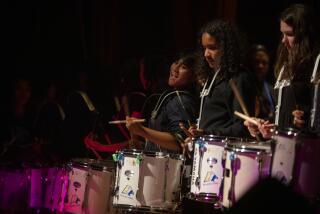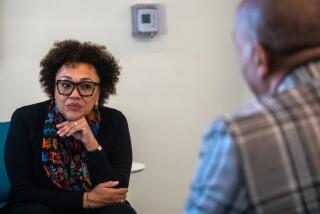President’s Committee tackles arts education
Hoping to reverse a decades-long decline in arts education in American elementary and secondary schools, the President’s Committee on the Arts and the Humanities has issued a report intended to help advocates press for more money, better teaching approaches and a fresh mind-set that doesn’t treat arts learning as a frill or an afterthought, readily cut when school budgets grow tight.
While acknowledging that “the overall picture can appear bleak,” the President’s Committee, co-chaired by film and television producer George Stevens Jr. and theater producer Margo Lion, argues in the report, “Reinvesting in Arts Education: Winning America’s Future Through Creative Schools,” that “a critical mass” of success stories now exists. The idea is to tell them to school boards, legislators and philanthropists in hopes of reversing drastic declines documented in a study the National Endowment for the Arts issued two months ago.
The NEA found across-the-board drops in arts education, based on 18- to 24-year-olds’ responses to a 2008 U.S. Census Bureau survey. Among children of a college graduate, 27% said they had never taken even one arts class, compared with 12% in 1982. For children of high school graduates, the number who’d never had any arts study rose from 30% nearly 30 years ago to 66% in 2008.
In an interview, Mary Schmidt Campbell, dean of New York University’s Tisch School of the Arts and vice-chair of the President’s Committee, and Rachel Goslins, the committee’s executive director, said the new, 76-page report consolidates in one place a raft of studies on the benefits of arts education and a list of model programs that others can copy.
“It gives [advocates] a more solid empirical basis for making their arguments,” Campbell said.
Goslins said that First Lady Michelle Obama is scheduled to discuss the findings Wednesday during a workshop for poetry students that she will host at the White House, in a prelude to that evening’s celebration of American poetry in the East Room. Beyond that, Goslins said, “we’re planning a year of outreach” in which the star-studded, 36-member arts and humanities committee aims to press the case in meetings with state and local policymakers and private funders. “One thing we can do as a presidential committee is get entree and convene folks at a very high level that some of the local arts agencies may not be able to do.”
Committee members include Vogue editor Anna Wintour, actors Forest Whitaker and Sarah Jessica Parker, painter Chuck Close, L.A. architect Thom Mayne, cellist Yo-Yo Ma and Creative Artists Agency managing director Bryan Lourd.
The report says that “while national leadership and more federal resources for arts education are critically important,” the idea is to encourage a variety of approaches rather than launch a federally-designed national arts education program.
Among the recommendations:
• Expand and intensify the use of practicing artists as teachers, including giving them instructional training to improve their work with students and ensure that their classes dovetail with the overall curriculum.
• Promote “arts integration,” in which regular classroom teachers interweave the arts with other subjects. The report acknowledges that “some advocates fear” school administrators will use arts integration as a cheap, watered-down substitute for arts courses taught by specialists.
• Develop ways to test students’ arts learning, comparable to achievement tests in other subjects, and promote research that will yield “more solid information” on how arts learning affects overall academic performance and students’ creative-thinking ability.
The report is posted at https://www.pcah.gov. Its opening summary acknowledges that, though it has been shown that students who receive strong arts education tend to do better in other subjects, it remains unproven whether studying art causes those improvements.
But in practical terms, Goslins said, the evidence is strong enough to be worth acting on. “You don’t hear anybody in the [Obama] administration saying ‘We don’t believe there’s a link.’” In his forward to “Reinvesting in Arts Education,” Obama’s education secretary, Arne Duncan, writes that the report “shows us the link between arts education and achievement in other subjects.”
But some experts say the question is not settled. Ellen Winner, who chairs the psychology department at Boston College and studies the nature of arts learning, said that while she enthusiastically supports arts education, there are holes in the research being used to make the case that students who study the arts will, as a direct result, improve in other subjects.
They may do better, Winner said — but that’s probably because of other positive forces at play in their schools and their lives. While it’s clear that students who take the most arts courses do better than their peers on standardized college entrance exams, she said, “you can’t infer arts is causing the test scores to go up. It could be kids who take lots of arts courses are very driven students.”
Winner said arts education advocates have criticized her in the past for questioning research that they feel advances their cause.
She’d rather promote arts education because, as she and a colleague, Lois Hetland, put it in a 2000 article, “the arts are a fundamentally important part of culture, and an education without them is an impoverished education leading to an impoverished society. Studying the arts should not have to be justified in terms of anything else…. they are time-honored ways of learning, knowing, and expressing.”
More to Read
The biggest entertainment stories
Get our big stories about Hollywood, film, television, music, arts, culture and more right in your inbox as soon as they publish.
You may occasionally receive promotional content from the Los Angeles Times.







